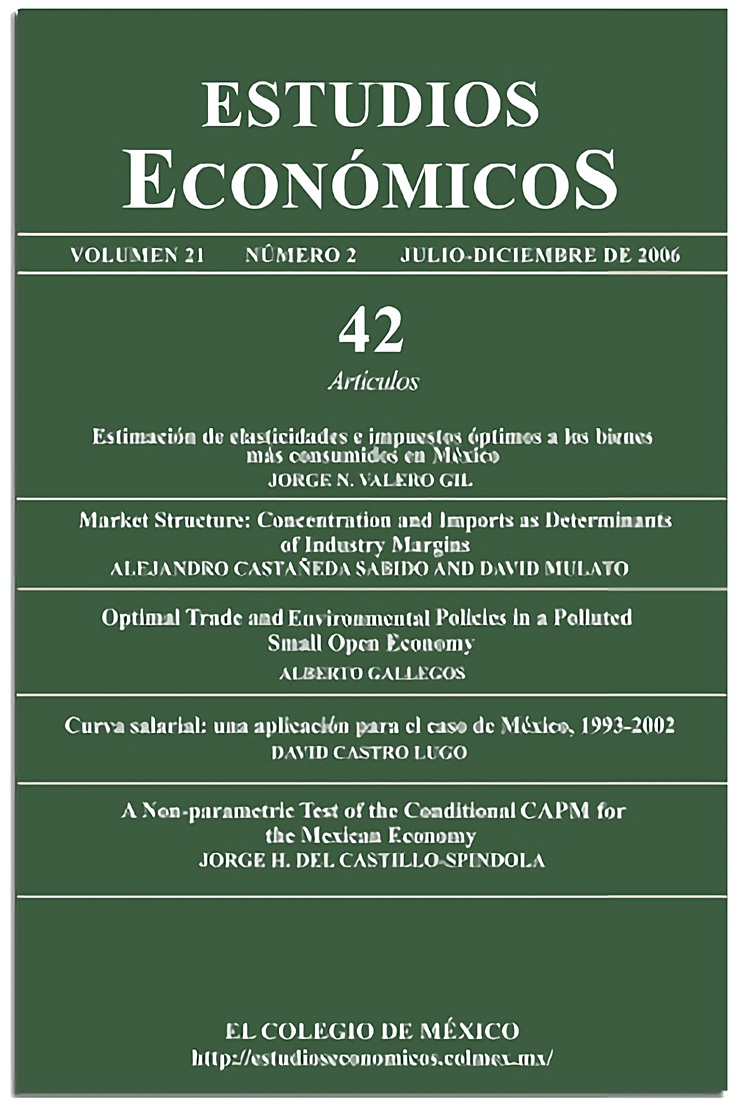Published 2006-07-01
Keywords
- price-cost margins,
- import penetration,
- concentration,
- cyclical effects
How to Cite
Abstract
The paper analyzes the determinants of price-cost margins following traditional industrial organization approaches. The price-cost margins are made function of the concentration index and the degree of import penetration. We find that imports act as a market disciplining device that reduces the price-cost margins of the domestic industry. After trade liberalization, the impact of concentration diminishes. Controlling for cyclical behavior of the price-cost margins the paper shows that cross-section studies tend to bias the estimates. A distinction between durables and non-durables is made, finding strong evidence for concentration to affect the price-cost margins of durables.
Downloads
References
- Athey, Bagwell, and Sanchirico (2002). Collusion and Price Rigidity, (mimeo).
- Bain, J. S. (1951). Relation of Profit Rate to Industry Concentration: American Manufacturing, 1936-1940, Quarterly Journal of Economics, 65, 293-324.
- Bresnahan, T. (1989). Empirical Studies of Industries with Market Power, in R. Schmalensee and R. D. Willig (eds.), Handbook of Industrial Organization, vol. II, North-Holland.
- Collins, N. R. and L. E. Preston (1969). Price Cost Margins and Industry Structure, Review of Economics and Statistics, 51, 271-286.
- Domowitz, I., R. G. Hubbard and B. C. Petersen (1988). Market Structure and Cyclical Fluctuations in U.S. Manufacturing, The Review of Economics and Statistics, 70, 55-66.
- Domowitz, I., R. G. Hubbard and B. C. Petersen (1986a). The intertemporal stability of the concentration-margins relationship. The Journal of Industrial of Economics, 35, 13-34.
- Domowitz, I., R. G. Hubbard and B. C. Petersen (1986b). Business Cycles and the Relationship between Concentration and Price-Cost Margins, Rand Journal of Economics, 17, 1-17.
- Geroski, P. A. and A. Jacquemin (1981). Imports as a Competitive Discipline, Recherches Economiques de Louvain, 47, 197-208.
- Grether, J. M. (1996). México, 1985-1990: Trade Liberalization, Market Structure, and Manufacturing Performance", in M. J. Roberts and J. R. Tybout (eds.), Industrial Evolution in Developing Countries, Oxford University Press.
- Green, E. and R. Porter (1984). Non-cooperative Collusion under Imperfect Price Information, Econometrica, 52, 87-100.
- Haltiwanger J. and J. E. Harrington Jr. (1991). The Impact of Cyclical Demand Movements on Collusive Behavior, Rand Journal of Economics, 22, 89-106.
- Hall, R. E. (1988). The Relation between Price and Marginal Cost in US Industry, Journal of Political Economy, 96, 921-947.
- Jacquemin, A. (1982). Imperfect Market Structure and International Trade- Some Recent Research, Kyklos, 35, 75-93.
- McGahan A. M. (1999). The Performance of US Corporations: 1981-1994, Journal of Industrial Economics, 47, 373-398.
- Nadiri, I. M. and R. Prucha (1996). Estimation of the Depreciation Rate of Physical and R&D Capital in the US Total Manufacturing Sector, Economic Inquiry, 34, 43-56.
- Nelson, R. L. (1963). Concentration in the Manufacturing Industries of the United States, Yale University Press.
- Nelson, C. R. and R. Startz (1988). Some Further Results on the Exact Small Sample Properties of the Instrumental Variable Estimator, NBER TWP no. 68.
- Pugel, T. A. (1980). Foreign Trade and US Market Performance, Journal of Industrial Economics, 29, 19-130.
- Rotemberg, J. and G. Saloner (1986). A Supergame-Theoretic Model of Price Wars during Booms, American Economic Review, 76, 390-407.
- Solow, R. (1957). Technical Change and the Aggregate Production Function, Review of Economics and Statistics, 39, 312-330.
- Tirole, J. (1988). The Theory of Industrial Organization, MIT Press.

